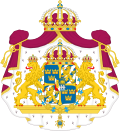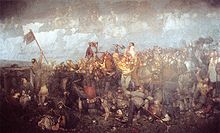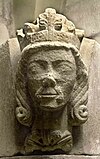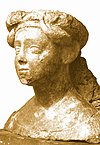
A | B | C | D | E | F | G | H | CH | I | J | K | L | M | N | O | P | Q | R | S | T | U | V | W | X | Y | Z | 0 | 1 | 2 | 3 | 4 | 5 | 6 | 7 | 8 | 9
| King of Sweden | |
|---|---|
| Sveriges konung | |
 | |
| Incumbent | |
 | |
| Carl XVI Gustaf since 15 September 1973 | |
| Details | |
| Style | His Majesty |
| Heir apparent | Victoria |
| Formation | Before c. 970 |
| Residence | Stockholm Palace Drottningholm Palace |
| Appointer | Elective monarchy (up to 1544) Hereditary monarchy (since 1544) |
| Website | www |
This list records the monarchs of Sweden, from the late Viking Age to the present day. Sweden has continuously been a monarchy since the country's consolidation in the Viking Age and early Middle Ages, for over a thousand years.[1] The incumbent royal dynasty of Sweden is the House of Bernadotte, established on the throne in 1818.
History

There were organized political structures in Sweden before the kingdom was unified; based on archaelogical evidence, early tribal societies are believed to have transitioned into organized chiefdoms in the first few centuries AD, perhaps spurred by contacts with the Roman Empire and the rest of Europe.[2] In the period AD 500–800, Scandinavian societies began adopting cultural elements from the newly established Germanic kingdoms in Europe, transitioning further into petty kingdoms.[3]
Archaeological evidence suggests that were numerous petty kingdoms throughout modern-day Sweden. Foreign sources and later native sources describe the later medieval kingdom as being composed of two main regions: Svealand (particularly around Lake Mälaren) and Götaland. Sources from as early as the Roman author Tacitus (c. 56–126) mention two main peoples or tribes in modern Sweden: the Svear (Swedes) and Götar (Geats); the Svear are mentioned in more foreign sources than the Götar, credited with military activities at sea.[4] The securely attested Swedish rulers in the Viking Age, predecessors of the later line of Swedish kings, ruled from the religious and political center of Old Uppsala; though its history before the Viking Age is poorly attested, it is probable that Old Uppsala had been a political and religious center since the Migration Period.[5]

The earliest historically attested Swedish rulers are 9th-century petty kings from the Vita Ansgarii, an account written c. 870 by Rimbert partly concerning Saint Ansgar's visit to Svealand.[6][7] Some kings of Old Uppsala are also mentioned in later Icelandic texts and sagas.[8] The line of legendary Swedish kings from Icelandic tradition, called sagokungar in Swedish, are not generally treated as historical figures, though some may be based on actual chieftains or petty kings.[7] Some later king-lists deliberately extended the sequence of kings for nationalistic purposes, such as Johannes Magnus's Historia de omnibus Gothorum Sueonumque regibus (1554); supposed ancient kings mentioned in such sources are clearly fictional.[7]
The petty kingdoms eventually gave rise to more complex political structures and what is today considered the beginning of the Swedish kingdom developed over the course of the Viking Age and the subsequent Middle Ages. For a consecutive list from then, the first Swedish king of whom anything definite is known is the 10th-century Eric the Victorious, though the information reported about him in different sources is scarce. Eric's son Olof Skötkonung was the first king to be baptized in Sweden and is credited with founding a Christian kingdom. The early and then medieval Swedish kingdom was an elective monarchy, with kings being elected from particularly prominent families;[9] this practice did however often result in de facto dynastic succession [10] and the formation of royal dynasties, such as those of Eric (intermittently c. 1157–1250) and Bjelbo (1250–1364) as well as infighting between rival families.
From 1389 to 1523, Sweden was often united with Denmark and Norway under the kings of the Kalmar Union. Sweden's full independence was restored under Gustav I in 1523. He is often credited as the founder of modern Sweden,[11] and in 1544 he formally abandoned the previous elective monarchy in favor of hereditary succession.[12] Initially adopting the medieval "King of Swedes and Geats", Gustav I later adopted the lengthier title rex Svecorum Gothorum Vandalorumque ("king of the Swedes, Geats and Wends").[13] The last monarch to be titled as king of the Swedes, Geats and Wends was Gustaf VI Adolf (r. 1950–1973) since his successor, the present king Carl XVI Gustaf, upon his accession adopted the shortened title "King of Sweden".[14]
In 1980, the rule of succession was changed from agnatic to absolute primogeniture, to the benefit of Princess Victoria (born 1977), the current heir apparent.
Monarchs and regents of Sweden
House of Munsö (970–1060)
| Portrait | Name | Reign | Succession | Marriage(s) | Life details |
|---|---|---|---|---|---|
| Eric (VII)[a] "the Victorious" Erik Segersäll |
c. 970[b] – c. 995 (c. 25 years) |
First king about whom anything definite is known[c] | Sigrid the Haughty (?) (2 children) |
c. 945 – c. 995 (aged approx. 50) Attributed various wives and children in different sources[16][18] | |

|
Olof "Skötkonung"[d] |
c. 995 – c. 1022 (c. 27 years) |
Son of Eric the Victorious | Estrid of the Obotrites (2 children) |
c. 980 – c. 1022 (aged approx. 42) [16][20][21][22] |

|
Anund Jacob Anund Jakob |
c. 1022 – 1050 (c. 28 years) |
Son of Olof | Gunnhildr Sveinsdóttir (childless?) |
c. 1008 – 1050 (aged approx. 42) [9][20][23][24] |
| Emund "the Old" Emund den gamle |
c. 1050 – 1060 (10 years) |
Illegitimate son of Olof | Astrid Njalsdotter (?) (2 children) |
Died 1060 Last king of the House of Munsö[9][20] |
House of Stenkil (1060–1125/1130)
| Portrait | Name | Reign | Succession | Marriage(s) | Life details |
|---|---|---|---|---|---|
| Stenkil Stenkil Ragnvaldsson |
c. 1060 – 1066 (c. 6 years) |
Possibly son-in-law of Emund[e] | "Ingamoder" (?) (at least 2 children) |
Died c. 1066 [9][20] | |
| Eric and Eric[a] Erik och Erik (historicity disputed) |
c. 1066 (?) (briefly) |
Recorded in only one source[f] as two pretenders who fought each other after Stenkil's death. | Nothing recorded | Nothing known[g] | |
| Halsten Halsten Stenkilsson |
c. 1066 – 1068[28] (c. 2 years) |
Son of Stenkil | Unknown queen (at least 2 children) |
Few life details known. Deposed c. 1068. Possibly later returned to rule as co-ruler with his (likely younger) brother Inge I.[29][28] | |
| Anund "from Russia" Anund Gårdske (historicity disputed) |
c. 1068 – 1076[28] (?) (c. 8 years) |
Recorded in only one source[h] as elected king after Halsten's deposition | Nothing recorded | Few life details known; said to have come from Kievan Rus'. Deposed c. 1076.[30][28] | |
| Håkan "the Red" Håkan Röde |
1070s (?) | Possibly great-grandson of Eric the Victorious.[31] | Nothing recorded | Few life details known. Different sources place Håkan either as the predecessor of Stenkil or Inge.[31][32] | |
| Inge "the Elder" Inge den äldre |
c. 1078 – 1112 (c. 34 years) |
Son of Stenkil. Seized power, either from Anund or Håkan. | Helena (4 children) |
Died c. 1112 Ended the period of anarchy begun after Stenkil's death. Maybe deposed c. 1081–1083 before regaining the throne.[29][20] | |
| Sweyn ("Blot-Sweyn") Blot-Sven (historicity disputed) |
c. 1081 – 1083 (c. 2 years) |
Possibly son-in-law of Stenkil. Said to have usurped the throne. | Nothing recorded | Few life details known. Historicity disputed on account of poor source material.[33] Either deposed or succeeded by his son.[20][33][34] | |
| Eric (VIII)[a] "Årsäll" Erik Årsäll (historicity disputed) |
c. 1083 (?) (briefly) |
Possibly son of Sweyn, who some sources record him as succeeding | Nothing recorded | Few life details known. Historicity disputed on account of poor and contradictory sources.[35] Deposed by Inge if historical.[34][35] | |
| Philip Filip Halstensson |
c. 1100 – 1118[36] (c. 18 years) |
Son of Halsten. Appears to have begun his reign as a co-ruler with Inge the Elder. | Ingegerd of Norway (childless) |
Died 1118 [20][36] | |
| Inge "the Younger" Inge (den yngre) Halstensson |
c. 1118[36] – 1125[37]/1130[20] (c. 7–12 years) |
Son of Halsten. Possibly initially co-ruler with Philip. | Ulvhild Håkansdotter (childless) |
Died c. 1130[20] Likely the last male-line member of Stenkil's dynasty.[20][38] | |
| Ragnvald "Knaphövde" |
1120s/1130s (?)[32] (briefly?) |
No known connection to previous kings. Recorded in Västgötalagen as the successor of Inge II and predecessor of Sverker I. | Nothing recorded | Few life details known[32][39] |
Houses of Sverker and Eric (1125/1130–1250)
| Portrait | Name | Reign | Succession | Marriage(s) | Life details |
|---|---|---|---|---|---|
| Magnus I "the Strong" Magnus (den starke) Nilsson (status disputed) |
c. 1125 – 1130[37] or c. 1130 – 1134[20] (c. 4–5 years) |
Grandson of Inge the Elder.[40] Attested only as a pretender in the Gesta Danorum; perhaps never recognized as king.[41] | Richeza of Poland (2 children) |
Died in 1134[20] Elected king but failed to establish his power; killed in 1134[20] at the Battle of Fotevik. | |

|
Sverker I "the Elder" Sverker den äldre |
c. 1130[42] – 25 December 1156[43] (c. 26 years) |
Either no previous royal connection[44] or grandson of Sweyn.[20] Elected in opposition to Magnus I.[44] | Ulvhild Håkansdotter (at least 4 children) Richeza of Poland (1 child?) |
Died 25 December 1156 Assassinated, allegedly by the pretender Magnus II.[20][44] |

|
Eric (IX)[a] "the Holy" Erik (den helige) Jedvardsson |
c. 1157[45] – 18 May 1160[43] (c. 3 years) |
Cousin of Sverker I | Christina of Denmark (4 children) |
c. 1120 – 18 May 1160[43] (aged approx. 40) Attempted to christianize Finland. Murdered by the pretender Magnus II and later canonized, becoming Sweden's patron saint.[20] |
| Magnus II Magnus Henriksson |
18 May 1160 – 1161 (1 year) |
Great-grandson of Inge I. Seized power after murdering Eric IX. | Bridget Haraldsdotter (childless) |
Died in 1161 Killed in battle against Charles VII.[43][46] | |

|
Charles (VII)[a] Karl Sverkersson |
c. 1157 – 12 April 1167[43] (c. 10 years; ruled all of Sweden from 1161 onwards) |
Son of Sverker I. Initially ruled in Västergötland in opposition to Eric IX; later overthrew Magnus II. | Christina Hvide (at least 1 child) |
1130 – 12 April 1167 (aged 37) Murdered by Canute I, who succeeded him as king.[20][43][47] |

|
Canute I Knut Eriksson |
12 April 1167 – 1196 (29 years) |
Son of Eric IX. Seized power after murdering Charles VII. | Cecilia Johansdotter (name disputed) (5 children) |
Before 1150 – 1196 (older than 46) [20][43][48] |
| Kol (status disputed) |
1170s (several years) |
Sons (?) of Sverker I. Ruled together in Östergötland, in opposition to Canute I. | Nothing recorded | Few life details known[49] | |
| Boleslaw Burislev (status disputed) |
1170s (several years) |
Nothing recorded | Few life details known[49] | ||

|
Sverker II "the Younger" Sverker (den yngre) Karlsson |
1196 – 1208 (12 years) |
Son of Charles VII | Benedicta Hvide (at least 1 child) |
c. 1164 – 17 July 1210 (aged c. 46) Deposed after the Battle of Lena. Killed at the Battle of Gestilren while trying to retake the throne.[43][50][51] |
| Ingegerd Birgersdotter (at least 1 child) | |||||

|
Eric (X)[a] "the Survivor" Erik Knutsson |
1208 – 10 April 1216 (8 years) |
Son of Canute I. Seized power after defeating Sverker II in battle. | Richeza of Denmark (5 children) |
1180 – 10 April 1216 (aged c. 36) [43][52] |

|
John I Johan Sverkersson |
10 April 1216 – 10 March 1222 (5 years and 11 months) |
Son of Sverker II | Unmarried and childless | 1201 – 10 March 1222 (aged c. 21) Died of illness as the last male-line member of Sverker's dynasty.[43][53] |

|
Eric (XI)[a] "the Lisp and Lame" Erik Eriksson |
March 1222 – 1229 (7 years) (first reign) |
Son of Eric X | Catherine Sunesdotter (childless) |
1216 – 2 February 1250 (aged c. 34) Largely overshadowed by prominent statesmen. Deposed and in exile 1229–1234.[43][54] |

|
Canute II "the Tall" Knut Holmgersson |
1229 – 1234 (5 years) |
Relative of the House of Eric. Elected king after the deposition of Eric XI. | Unknown queen (at least 2 children) |
Died 1234 [43][55] |

|
Eric (XI)[a] "the Lisp and Lame" Erik Eriksson |
1234 – 2 February 1250 (16 years) (second reign) |
Returned and regained power after Canute II's death[43][55] | Catherine Sunesdotter (childless) |
(see entry for previous reign) |
House of Bjelbo (1250–1364)
| Portrait | Name | Arms | Reign | Succession | Marriage(s) | Life details |
|---|---|---|---|---|---|---|

|
Valdemar Valdemar Birgersson |

|
1250 – 22 July 1275 (25 years) |
Grandson of Eric X and son of the prominent statesman Birger Jarl | Sophia of Denmark (6 children) |
1239 – 26 December 1302 (aged c. 63) Deposed after losing the Battle of Hova (1275). Continued to try to regain parts of the kingdom before being imprisoned in 1288.[56] |

|
Magnus III "Barnlock" Magnus (Ladulås) Birgersson |

|
22 July 1275 – 18 December 1290 (15 years, 4 months and 26 days) |
Grandson of Eric X and son of the prominent statesman Birger Jarl. Seized power after defeating Valdemar in battle. | Helvig of Holstein (5 children) |
Died 18 December 1290 [56] |

|
Birger Birger Magnusson |
18 December 1290 – March/April 1318 (28 years and 5/6 months) |
Son of Magnus III | Martha of Denmark (4 children) |
1280 – 31 May 1321 (aged c. 41) Deposed and forced into exile by supporters of his brother Eric in 1318.[57] | |
| Regency of Duchess Ingeborg (March/April 1318 – 8 July 1319) | ||||||

|
Magnus IV Magnus Eriksson |

|
8 July 1319 – 15 February 1364 (44 years, 7 months and 7 days) |
Grandson of Magnus III | Blanche of Namur (5 children) |
c. 1316 – 1 December 1374 (aged c. 58) Also king of Norway (1319–1355). Deposed in favor of Albert and imprisoned until 1371; thereafter lived in exile in Norway.[58] |

|
Eric (XII)[a] Erik Magnusson |
17 October 1356 – 20 June 1359 (2 years, 8 months and 3 days) |
Son of Magnus IV. Initially ruled in opposition to his father; became co-ruler following reconciliation in 1359. | Beatrice of Bavaria (childless) |
In or before 1339 – 20 June 1359 (aged at least 20) [59] | |

|
Håkan Håkan Magnusson |

|
15 February 1362 – 15 February 1364 (2 years) |
Son of Magnus IV, co-ruler with his father | Margaret of Denmark (ruling queen 1389–1412) (1 child) |
1340 – 11 September 1380 (aged c. 40) Also king of Norway (1343–1380). Deposed in favor of Albert, tried to reclaim Sweden until his defeat at the Siege of Stockholm in 1371.[60] |
House of Mecklenburg (1364–1389)
| Portrait | Name | Arms | Reign | Succession | Marriage(s) | Life details |
|---|---|---|---|---|---|---|

|
Albert of Mecklenburg Albrekt av Mecklenburg |

|
15 February 1364 – 24 February 1389 (25 years and 9 days) |
Great-grandson of Magnus III of Sweden | Richardis of Schwerin (2 children) Agnes of Brunswick-Lüneburg (1 child) |
c. 1340[61] – 1 April 1412 (aged c. 72) Also Duke of Mecklenburg (1384–1412). Defeated by Margaret at the Battle of Åsle and then deposed.[61] |

